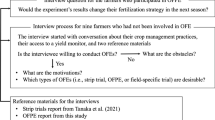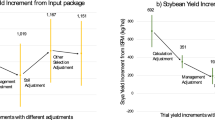Abstract
A major recurrent problem of agronomic research is whether its results can be transformed into recommendations relevant to the livelihood of the intended beneficiaries, the small farmers—and if they can, then how. This problem is illuminated by research on mulching with millet crop residues, and by the translation of the results into agricultural extension in Niger, West Africa. Comparisons of different experiments with identical crop residue applications, conducted in the same year and at the same research station but implemented on different fields and managed by different researchers, showed high heterogeneity in their outcome. In addition, farmers have multiple uses for crop residues, which greatly complicates the formulation and transfer of research recommendations. This discussion is examined from agronomic, economic, and extension viewpoints. The development of adapted innovations for farming systems in Niger requires that the current agronomic research be reconsidered, with a move toward greater participation of farmers. Alternatives to the dominant transfer of technology concept are discussed.
Similar content being viewed by others
References
Albrecht, Hartmut. “Extension Research: Needs and Uses.” InInvesting in Rural Extension: Strategies and Goals, edited by Gwyn E. Jones, 239–245. London and New York: Elsevier Applied Science Publishers, 1986.
Baidu-Forson, Jojo. “Characteristics of Farm Households and Economy in Western Niger Villages: Some Evidence from Baseline Surveys.” Progress Report no. 87. International Crops Research Institute for the Semi-Arid Tropics, Resource Management Program, Economics Group, Niamey, Niger, 1988.
Baidu-Forson, Jojo. “Uses and Economic Value of Crop Residues and Herbaceous Plants to Rural Households in Western Niger.” Progress Report no. 5. International Crops Research Institute for the Semi-Arid Tropics. Resource Management Program, Niamey, Niger, 1994.
Bationo, André, A. Buerkert, M.P. Sedogo, B.C. Christianson, and A.U. Mokwunye. “A Critical Review of Crop Residue Use as Soil Amendment in the West African Semi-Arid Tropics.” InLivestock and Sustainable Nutrient Cycling in Mixed Farming Systems of Sub-Saharan Africa, edited by J.M. Powell. International Livestock Centre for Africa (ILCA), Addis Ababa, Ethiopia, in press.
Bationo, André, and A.U. Mokwunye. “Role of Manures and Crop Residue in Alleviating Soil Fertility Constraints to Crop Production: With Special Reference to the Sahelian and Sudanian Zones of West-Africa.”Fertilizer Research 29 (1991): 117–25.
Bawden, Richard J., R.D. Macadam, R.J. Packham, and I. Valentine. “Systems Thinking and Practices in the Education of Agriculturalists.”Agricultural Systems 13 (1984): 205–225.
Buerkert, Andreas, R.D. Stern, and H. Marschner. “Soil Variability and Millet Growth in the Sahel: From Simple Analysis of Variance toEx-Post Blocking.” Forthcoming inAgronomy Journal (1995).
Chambers, Robert, and J.L.S. Jiggins. “Agricultural Research for Resource-Poor Farmers: A Parsimonious Paradigm.” Discussion Paper 220. Institute of Development Studies, University of Sussex, Brighton, 1986.
De Wit, Cornelis T. “Integrating Agricultural Research and Development.”Quarterly Journal of International Agriculture 26, no. 3 (1987): 311–24.
Engels, Peter G.H., and S. Seegers. “Basis Configuration in Agricultural Technology Systems.” InAgricultural Knowledge Systems and the Role of Extension, edited by Hermann J. Tillmannet al., 353–359. University of Stuttgart-Hohenheim, Germany. 1991.
Food and Agricultural Organization of the United Nations. “AGROSTAT-PC.” Computerized Information Series. Statistics Land Use. FAO, Rome 1993.
Feder, Gershon, R.E. Just, and D. Zilberman. “Adoption of Agricultural Innovations Under Low Resource Farmer Conditions: A Survey.”Economic Development and Cultural Change 33, no. 2 (1985): 255–298.
Feil, Petra R., and J.P.A. Lamers. “Farmers' Knowledge on Wind Erosion and Their Usage of Millet Crop Residues and Trees.” Forthcoming inThe Control of Wind Erosion in Niger: A Case Study, edited by Barbara Buerkert, B.E. Allison, and M. von Oppen. 1995.
Haverkort, Bertus, J. van der Kamp, and A. Waters-Bayer, eds.Joining Farmers' Experiments. Experiences in Participatory Technology Development. London: Intermediate Technology Publication, 1991.
Herrmann, Ludger, A. Hebel, and K. Stahr. “Influence of Microvariability in Sandy Sahelian Soils on Millet Growth.”Zeitschrift für Pflanzenernährung und Bodenkunde 157 (1994): 111–115.
Ikpe, Felix N., J.M. Powell, and N.O. Isirimah. “Primary Tillage and Nutrient Cycling in Mixed Farming Systems of Semi-Arid West-Africa (SAWA). InRéseau Erosion, Proceedings of the 10th Workshop on Soil Erosion, edited by G. de Noni, J.F. Nouvelot, and E. Roose, 410–437. Bulletin no. 14. ORSTOM, France, 1994.
Ison, R.L. “Teaching Threatens Sustainable Agriculture. “Gate Keepers Series, no. SA21. London: International Institute for Environment and Development, 1990.
Lamers, John P.A., and M. Bruentrup. “Comparative Advantage of Single and Multipurpose Uses of Millet Stover in Niger.”Agricultural Systems. In press, 1995.
Lamers, John P.A., and P.R. Feil. “The Many Uses of Millet Residues.”ILEIA Newsletter 9, no. 2 (1993): 15.
Lipton, Michael, and R. Longhurst.New Seeds and Poor People. London: Unwin Hyman, 1989.
Long, Norman, and A. Long, eds.Battlefield of Knowledge: The Interlocking of Theory and Practice In Social Research and Development. London: Routledge, 1992.
Matlon, Peter J., and D.S.C. Spencer. “Increasing Food Production in Sub-Saharan Africa. Environmental Problems and Inadequate Technological Solutions.”American Journal of Agricultural Economics 66, no. 5 (1984): 671–676.
Merill-Sands, Deborah, P. Ewell, S. Biggs, and J. McAllister. “Issues in Institutionalizing On-Farm Client-Oriented Research: A Review of Experiences from Nine National Agricultural Research Systems.”Quarterly Journal of International Agriculture 28, nos. 3 & 4 (1989): 279–301.
Michels, Karlheinz.Wind Erosion in the Southern Sahelian Zone. Extent, Control, and Effects on Millet Production. Stuttgart: Ulrich Grauer Verlag, 1994.
Piéri, Christian.Fertilité des Terres de Savannes. Bilan de Trente Ans de Recherche et de Développement Agricoles au Sud du Sahara. Montpellier, France: CIRAD/IRAT, 1989.
Rebafka, Franz-Peter. “Deficiency of Phosphorus and Molybdenum as Major Growth Limiting Factors of Pearl Millet and Groundnut on an Acid Sandy Soil in Niger, West Africa.” Hohenheimer Bodenkundliches Heft no. 9. University of Stuttgart-Hohenheim, 1993.
Röling, Niels G.Extension Science: Information Systems in Agricultural Development. Cambridge: Cambridge University Press, 1988.
Sivakumar, M.V.K. “Predicting Rainy Season Potential from the Onset of Rains in Southern Sahelian and Sudanian Climatic Zones of West Africa.” Agricultural and Forest Meteorology 42 (1988): 295–305.
Thompson, Thomas P., and C.A. Baanante. “A Socioeconomic Study of Farm-Level Constraints to Fertilizer Use in Western Niger.” IFDC Paper Series, no. P-6. Muscle Shoals, Alabama, 1988.
Venkatesan, V., and L. Schwartz. “Agricultural Service Initiative.” Report based on the World Bank Workshop, Lilongwe Malawi, February 1991. Agriculture and Rural Development Series no. 4. Technical Development, Africa Region. Washington: World Bank, 1992.
Warren, Michael D., D. Brokensha, and L.J. Slikkerveer, eds.Indigenous Knowledge Systems: The Cultural Dimension of Development. London: Paul Kegan International, 1991.
West, Larry, L.P. Wilding, J.K. Landeck, and F.G. Calhoun. “Soil Survey of the ICRISAT Sahelian Center, Niger, West Africa.” Texas A&M University, Soil and Crop Sciences Department/Trop Soils, 1984.
Rights and permissions
About this article
Cite this article
Feil, P.R., Lamers, J.P.A. & Herrmann, L. Knowledge transfer in the field: Solving crop residue problems in Niger. J Technol Transfer 20, 31–41 (1995). https://doi.org/10.1007/BF02175119
Issue Date:
DOI: https://doi.org/10.1007/BF02175119




